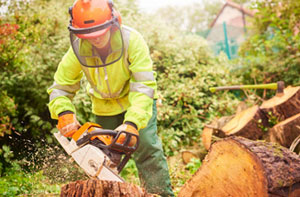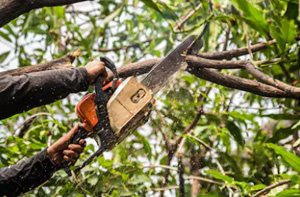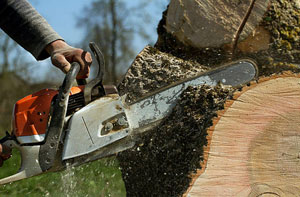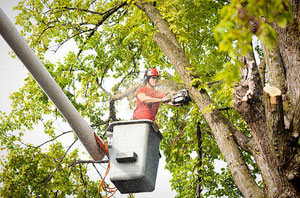Bearsted Tree Surgeon Kent: Trees in your garden and around your property in Bearsted, add structure, style and substance to what can oftentimes be a two dimensional area. However, when trees are neglected or have been impacted by damaging weather conditions, for example flooding or gales, problems may develop. Seeking the advice of a trained tree surgeon in Bearsted, is the best option when there's work that needs doing on your trees.
Using non-qualified individuals for tree work or attempting to do the work yourself, could cause damage to property, harm your trees, or even be life threatening. But even hiring a skilled tree surgeon who is acquainted with all the hazards does not necessarily mean that tree work is entirely safe. Within the profession there are a worrying average of 3 deaths and 140 severe injuries a year, making tree surgery among the most dangerous jobs in the United Kingdom.

With falling branches and trees causing around five fatalities a year in Britain, a threat to life can even be presented by a damaged or poorly maintained tree. You could be liable for any compensation to any third-party as a consequence of your actions, if you employ somebody to perform tree work and there is an injury, or damage to property. This is why it is imperative to retain the services of a skilled tree surgeon to carry out the work on your trees. (Source - HSE UK).
There are 2 main professional arboricultural bodies, one or both of which a skilled tree surgeon in Bearsted should be an approved member of. You can check up on the membership and professional status of any tree surgeon on the websites of either the International Society of Arboriculture (ISA) or the Arboricultural Association (AA). Membership of either of these organisations gives the tree surgeon ARB Approved Contractor status which can be checked out on this page.
If there's a problem during the work, or after it's been finished you will be able to communicate with these professional organisations for assistance in arbitration and for guidance and help.

You should not be frightened to decline the offer of a price quote from somebody who you can't find on this directory, since after all, it is an approved contractor that you are looking for. It is a good idea to get a minimum of three quotations from different companies in the Bearsted area, as soon as you have meticulously checked their accreditations and professional memberships. While obtaining these quotes you must ask the questions below, making it crystal clear that you need to know the answers because of the risks of the work involved:
- Precisely what is your level of insurance cover? Don't consider a tree surgeon in Bearsted with less than £5 Million public liability insurance as set out by the AA and ISA.
- Can you provide a written quotation? Verbal quotes alone aren't acceptable. Always get a quote in writing.
- Can you show a NPTC/LANTRA certificate for the use of a chainsaw, and documentary proof of your professional memberships and qualifications? Any tree worker using a chainsaw, must by law have gained a NPTC/LANTRA certificate. A seasoned Bearsted tree surgeon might hold Certificates and National Diplomas in Arboriculture.
- Can I contact some past customers to check the standard of your workmanship? Doing an independent examination of any recent work is always recommended.
On the written quotation that you receive, you'll need there to be easily followed details about all the work that is to be undertaken. It should state whose responsibility it is to remove debris, tree branches and stumps, and should also include information on any trees which might be protected, and the steps required to get permission to carry out work on them. You should also ensure that VAT has been included on the quote. Recognising that you have a responsibility for employing only qualified tradespeople to work on your trees and property, is vitally important.
PRIOR TO WORK - Checking into the possibility of any trees being protected, your chosen Bearsted tree surgeon should make certain that any tree work gets the go-ahead from the appropriate local authorities. Finding that a tree has protected status doesn't mean that work cannot be carried out, since even protected trees require maintenance so as to cut back dead or damaged wood and ensure the safety of the public.
No less than 6 weeks written notice must be given to the Local Planning Authority (LPA) before any tree work can be performed, if your property in Bearsted is within a conservation area. This is only applicable to trees with a stem diameter of more than 7.5cm in diameter, at a point 1.5m from the ground. Also, it isn't necessary to give notice if a protected tree's branches need pruning or thinning simply to sustain and encourage growth.

After conducting a full assessment of your trees health, your chosen Bearsted tree surgeon will decide on the necessary remedial treatment and how the required outcome can be achieved with safety in mind. Public spaces, your property and any sections of neighbouring properties that could be affected by falling debris and branches will all be given a full risk assessment. This stage will also ascertain the level of protection required and the amount of workforce needed. This is both PPE (personal protective equipment) in addition to other safety measures to keep the public and other property safe from harm or damage.
ON THE DAY OF WORK - To keep unauthorised persons and passers-by away from the area of work, barriers and safety measures will be put in place before any tree felling, cutting of branches or climbing commences. If there is a threat of falling debris onto a public road, passing traffic might need to be stopped temporarily.
Different types of work will require the tree surgeon to have different levels of protection. When working with a chainsaw, they will at a bare minimum be wearing protective clothing to prevent cutting injuries to the legs, hands and torso. All workers involved in the operation must wear high visibility clothing, and eye and head protection, at all times.
Safety climbing equipment and ladders will be necessary if any working at height is involved, and to assist in the removal of high branches and heavy pieces of tree trunk, extra workers will be necessary. A pickup truck or skip for removing the waste will be stationed as close to the work area as possible, so it's advisable to inform your nearby neighbours of the need for access.
UPON COMPLETION OF WORK - As soon as the tree work has been completed all the waste materials will be taken away and the site cleared of any debris. Your tree surgeon should then sign off and give you a certificate of work done, particularly when the trees are protected. Any safety measures that were put in public spaces can then be taken away, with highways and paths being re-opened to the public.
If you've got any complaints about the completed work, you should get them rectified straight away by firstly speaking to your tree surgeon. If your tree surgeon is a signed up member of a trade association, and any further arbitration is needed, you can get help and advice from the International Society of Arboriculture or the Arboricultural Association in order to come to a satisfactory solution.
Locally based Bearsted tree surgery services will probably have the postcode ME14 and the dialling code 01622. They'll work in Bearsted itself, in addition to nearby areas like Sandling, Leeds, Maidstone, Allington, Stoneacre, Boxley, Thurnham, Weavering, Downswood, Hollingbourne, Grove Green, Ware Street, Roseacre, Parkwood, Detling, Otham, and these postcodes: ME14 4AY, ME14 4EB, ME14 4BX, ME14 4HD, ME14 4DP, ME14 4DT, ME14 4JY, ME14 4DU, ME14 4LL, ME14 4AN.
For this type of service it's unquestionably a good idea to hire a competent tree surgeon. Bearsted home and property owners can benefit greatly from the expertise and knowledge that are the trademark of a seasoned professional.
Chainsaws in Tree Surgery

The most common piece of equipment that professional tree surgeons in Bearsted use is the chainsaw. It's an effective and versatile tool, but in untrained hands, a pretty dangerous one. Because of their ease of use and portability, petrol chainsaws are the most preferred by tree care professionals, although mains and battery versions are available. Petrol chainsaws are the only real choice for heavy tree work, being very powerful, robust and able to cut effortlessly through branches and limbs of any dimensions.
A chainsaw basically comprises a rotating motor-driven chain which is armed with a row of sharp teeth which cut through the bark of the tree and the wood beneath. Aside from what powers them, there are also different designs of chainsaw for different procedures, rear-handled for work at ground level (must always be used with two hands), top-handled for working at height (and which can be operated with one hand) and pole saws for hard to reach branches and long distance pruning.
You will seldom find a professional Bearsted tree surgeon who doesn't use a chainsaw, although being high up in a tree with a rapidly rotating blade in your hand isn't the safest activity. One of the main conditions for gaining membership of the Arboricultural Association, is that professional tree surgeons have to be fully trained in the safe use of chainsaws.
There are numerous different brands of chainsaw, but the most commonly used by professionals in the UK are Husqvarna, Makita, Stihl and Hyundai.
Cable Bracing Trees Bearsted
When a tree could be a danger to nearby pedestrians or property, or if it's showing warning signs of damage or decay, the tree can be offered extra support with a method known as tree cable bracing. This method is often used on valuable or older trees in Bearsted, where the felling or removal of large unstable portions must be avoided for reasons of aesthetics.
A cable bracing set-up can be implemented for supporting V-shaped forks, weak tree limbs and poor joints. Most Bearsted tree surgeons should be able to undertake various types of bracing work through the fitting of rods and cables to mitigate structural stresses and prolong the life of veteran trees.
Cable bracing doesn't cause additional damage to the tree (as would happen when drilling and bolting the branches), and provides a shock-absorbing and flexible method of support that is largely non-invasive. To guarantee the safety of the tree and nearby areas, a comprehensive risk assessment needs to be carried out before any actual cable bracing work can begin.
Eco-Plugging Stump Removal Bearsted
Stump grinding is the conventional technique employed by most tree surgeons in Bearsted for removing large tree stumps. However, nowadays "eco-plugging" is touted as a more cost-effective alternative to this procedure. Eco-plugging is not only less expensive, but it is also ideal for use in hard-to-reach locations that are inaccessible to stump grinding equipment.
Eco-plugging is an effective treatment for eliminating tree stumps and has no effect on the surrounding trees and vegetation. Eco-plugs kill off the whole root system of the tree stump and can be used throughout the year and in all weather. Containing a kind of granular glyphosate herbicide, eco-plugs are 95% to 100% effective, and can be used on a wide array of tree species. (Tags: Eco-Plugging Bearsted, Eco-Plug Stump Treatment Bearsted, Eco-Plugs Bearsted, Eco-Plugging Tree Stump Removal Bearsted).
Storm Damage Bearsted
Of all the things that grow in our gardens, trees give the impression of being the sturdiest, strongest and the most likely to survive the vicissitudes of Mother Nature. In fact certain types of trees can live and continue to grow for many hundreds of years.
Nevertheless, when confronted with a certain set of conditions they can be quite susceptible to the elements, and it isn't just falling tree limbs and branches that can be a consequence, but the entire tree can fall over in extreme weather. The primary weather related problem for trees is high winds, and as the frequency of violent weather events and storms in Bearsted escalates due to climate change, this sort of damage has become more commonplace. Other issues can be heavy winter snow, and waterlogged soil during extended periods of rain or flooding.
To trim and remove any dead or overhanging branches that might cause an issue in severe weather conditions, it's a good idea to get a competent Bearsted tree surgeon to examine your trees regularly.
To stop taller trees getting struck by lightning, and to safeguard nearby buildings and property which could be susceptible to side-flashes ("jumps"), it is also a good idea to fit them with lightning rods, copper conductors, or other lightning protection systems. Trees can be damaged, severely weakened, or even killed by a lightning strike, they can be burnt to the ground, split down the middle, or left vulnerable to disease, pests or decay. You might not imagine that lightning strikes are all that common, yet in the UK alone there are about three hundred thousand lightning strikes annually.
If you are concerned about the risk of your trees in Bearsted being damaged by storms, you should ask your local tree care specialist what can be done to safeguard them, and lower the risk of mishaps taking place. (Tags: Storm Damage Prevention Bearsted, Storm Damaged Trees Bearsted, Storm Damage Bearsted).
Dutch Elm Disease
Destroying tree stocks and killing many millions of precious elm trees all around Britain over the past five decades or more, Dutch Elm Disease (Ophiostoma novo-ulmi) isn't so common now, as it was previously. Inadvertently imported into the UK, by way of elm logs imported from Canada in the 1960's, DED (Dutch Elm Disease) is caused by the Ophiostoma novo-ulmi fungus which is spread by the elm bark beetle (Scolytus).
Through the movement of elm products like mulching bark, saplings, crates, and logs with the bark still attached, it was quickly spread through Britain after first arriving. Dutch Elm Disease didn't only affect the UK, but also decimated the stocks of elms in mainland Europe and North America, it is believed to have originated from Asia (most likely Japan).
The first signs of Dutch Elm Disease are:
- Clusters of leaves turning yellow and wilting.
- New shoots that die back from the tips.
- Twigs that turn into a "shepherd's crook" shape.
- Twigs with dark streaks beneath the bark.
It normally starts to appear in early summer.
The spread of DED has been slowed down by the felling and removal of dying, infected and dead trees, which has in essence eradicated the beetle's habitat. New saplings have also been propagated from trees that have proved to be resistant up to now.
If you are suspicious you may have elm trees on your property in Bearsted, that may be infected with Dutch Elm Disease, you could put in a request for a diagnosis from the Tree Health Diagnostic and Advisory Service (THDAS), or speak to your local tree surgeon for help and advice.
Ash Dieback (Hymenoscyphus Fraxineus)
Expected to decimate about eighty percent of the current British ash tree population, over the next few years, ash dieback is a chronic fungal disease of ash trees that was first documented in the UK in 2012. Set to have huge repercussions for our beloved countryside, ash dieback is destined to be just as damaging as the earlier epidemic of Dutch Elm Disease (DED).
A damaging disease of the Fraxinus genus of trees, ash dieback has a particularly disastrous effect on the Fraxinus excelsior (common ash), British Fraxinus excelsior (common or European ash). Believed to have originated in eastern Asia where the native species of ash (the Manchurian ash and the Chinese ash) were more resistant, the fungus which causes the disease is known as Hymenoscyphus fraxineus (H. fraxineus), and it blocks a tree's water transport (vascular) systems, causing it to die.
Readily spread by spores produced by the fruiting bodies of the fungus, and can travel for miles on the wind, ash dieback (or chalara ash dieback) is prevalent in most areas of the United Kingdom with up to 85 percent mortality rates.
The obvious symptoms of ash dieback are:
- New growth appearing from previously dormant buds (epicormic growth).
- Dark brown lesions (often diamond shaped) form where branches meet the trunk, and the inner bark under the lesions looks brownish grey.
- Dying leaves and shoots that are visible during the summertime.
- Leaves that wilt, turn black and fall prematurely.
- Dark patches on leaves during the summertime.
Even ash trees which have the ability to fight the infection, are attacked year after year and eventually succumb and die. There's presently no remedy for ash dieback, and no clear-cut strategy for stopping it spreading.
Whilst you can report instances of ash dieback to the "Tree Alert Service" provided by the Forestry Commission, it's now so commonplace all over Britain that they're only really interested to know about cases that are found in areas not affected previously. If you believe you have a tree suffering from ash dieback on your property in Bearsted, you should still speak to a local tree surgeon, who'll offer guidance about how to proceed - ultimately the tree or trees will have to be downed and removed.
Tree families affected by ash dieback: the Fraxinus genus (Fraxinus excelsior, EXTRAtree reduction in Bearsted, shrub maintenance Bearsted, hedge cutting Bearsted, drop crotching Bearsted, safety inspections in Bearsted, tree surveys, emergency tree surgery, root removal, tree topping, tree lightening protection, hedge reduction, crown removal in Bearsted, tree felling, cut sealing, stump treatment, arboriculture, tree care services in Bearsted, cable bracing Bearsted, tree bracing, tree removal, crown lifting in Bearsted, tree pest control, tree staking, tree planting in Bearsted, retrenchment pruning, hedge lowering, tree pollarding, stump grinding, repair of storm damaged trees, landscape clearingNINE).
Necessary Skills for Tree Surgeons in Bearsted
- Physical skills like movement and coordination.
- Be mindful of the dangers and complexities involved with the various areas of work.
- The ability to work successfully other people.
- Be professional and capable of completing tasks within a set period.
- Be able to work with your hands.
- Have an organised working approach.
- Have good customer service skills.
- Be patient and have the ability to remain focused in stressful situations.
- Have a good understanding of public safety.
- Be capable of using, repairing and maintaining tools and machines.
- To be able to perform common tasks on a computer or hand-held device.
A Tree Surgeons's Day to Day Duties
- Deal with customers and complete administrative duties.
- Tidy work area on completion and remove waste products from client's site.
- Identify dangers presented by trees.
- Produce telephone or on-site quotes with the customers.
- Be proficient with power tools and equipment.
- Produce tree survey reports for domestic and commercial clients.
- Plant trees and vegetation.
- Maintain and service equipment like wood chippers and chainsaws.
- Climb trees to remove or prune branches.
- Assess the health of trees and create plan of action.
- Fell and remove trees and perform stump grinding.
- Cut and chip branches and logs.
Tree Pollarding Bearsted

The technique whereby a tree's size is greatly decreased because it has outgrown its current setting, is referred to as "pollarding". It can occasionally be used for practical or visual motives to change a tree into a particular form. It is often seen on trees that serve as boundaries or hedgerows, in addition to trees that grow alongside roadways in Bearsted. The somewhat naked and stark appearance that results from pollarding isn't at all popular with tree lovers, given that it's so different from its attractive natural state. The beneficial element of pollarding, is that trees which may otherwise need to be cut down can be saved. Pollarding is frequently used on broad-leafed species like planes, beeches, maples, horse chestnuts, sycamores, oaks and limes.
Tree Surgery Tasks Bearsted

Bearsted tree surgeons can usually help with tree reduction in Bearsted, shrub maintenance Bearsted, hedge cutting Bearsted, drop crotching Bearsted, safety inspections in Bearsted, tree surveys, emergency tree surgery, root removal, tree topping, tree lightening protection, hedge reduction, crown removal in Bearsted, tree felling, cut sealing, stump treatment, arboriculture, tree care services in Bearsted, cable bracing Bearsted, tree bracing, tree removal, crown lifting in Bearsted, tree pest control, tree staking, tree planting in Bearsted, retrenchment pruning, hedge lowering, tree pollarding, stump grinding, repair of storm damaged trees, landscape clearing and other tree surgeon services in Bearsted, Kent. Listed are just a small portion of the tasks that are handled by a local tree surgeon. Bearsted specialists will let you know their full range of services.
Tree Surgeons Nearby
Also find: Parkwood tree surgeon, Sandling tree surgeon, Roseacre tree surgeon, Grove Green tree surgeon, Weavering tree surgeon, Detling tree surgeon, Hollingbourne tree surgeon, Stoneacre tree surgeon, Otham tree surgeon, Downswood tree surgeon, Thurnham tree surgeon, Allington tree surgeon and more. All these towns and areas are served by local tree surgeons. Property owners in the area can acquire tree surgery estimates by clicking here.
Tree Care Services Bearsted
- Bearsted Tree Watering
- Bearsted Tree Inspections
- Bearsted Shrub Maintenance
- Bearsted Stump Grinding
- Bearsted Root Removal
- Bearsted Crown Lifting
- Bearsted Wood Chipping
- Bearsted Tree Pruning
- Bearsted Crown Thinning
- Bearsted Hedge Planting
- Bearsted Crown Cleaning
- Bearsted Crown Removal
- Bearsted Soil Terraventing
- Bearsted Root Decompaction
 Tree Surgeon Bearsted
Tree Surgeon Bearsted Tree Care Bearsted
Tree Care Bearsted Tree Surgery Bearsted
Tree Surgery BearstedTo find local info relating to Bearsted, Kent check here
Tree Surgery ME14 area, 01622.
Tree Care Bearsted - Arboriculturalist Bearsted - Forest Management Bearsted - Tree Surgery Bearsted - Vegetation Management Kent - Stump Removal Bearsted - 01622 - Crown Reduction Bearsted - Tree Management Bearsted






